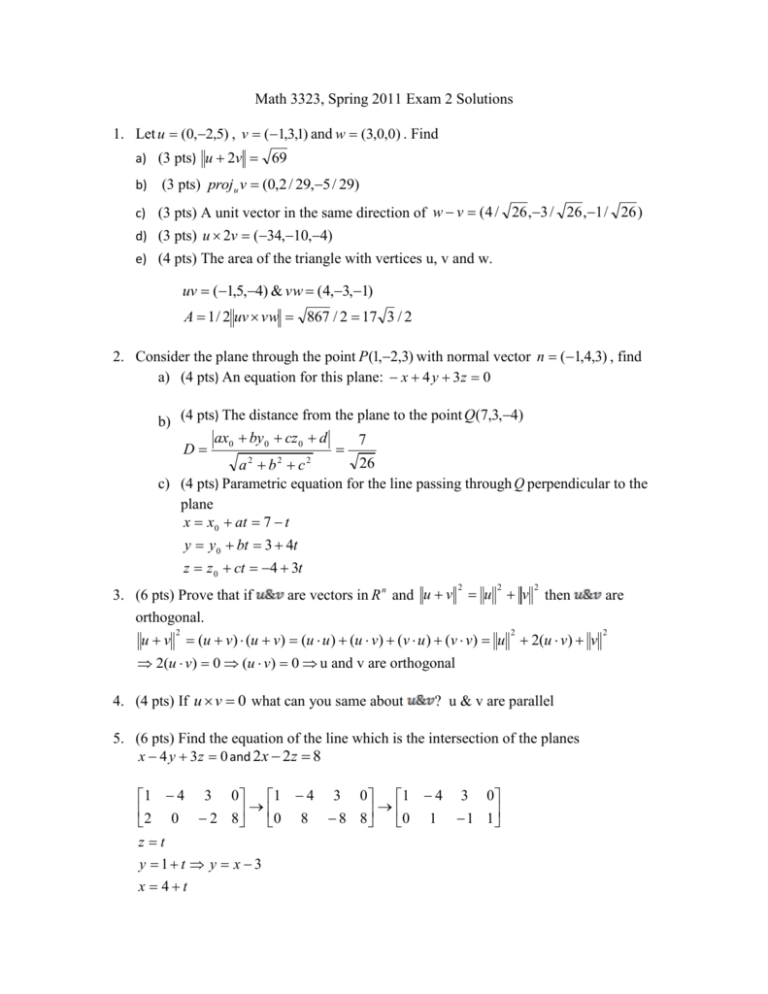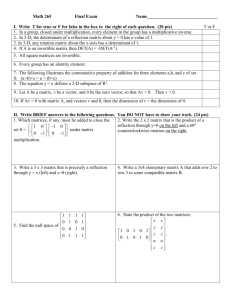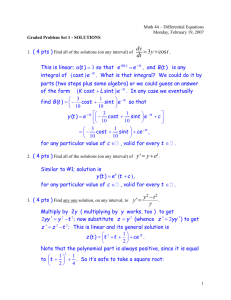Math 3323, Spring 2011 Exam 2 Solutions Let, and. Find a) (3 pts) b
advertisement

Math 3323, Spring 2011 Exam 2 Solutions
1. Let u (0,2,5) , v (1,3,1) and w (3,0,0) . Find
a) (3 pts) u 2v 69
b)
(3 pts) proj u v (0,2 / 29,5 / 29)
c) (3 pts) A unit vector in the same direction of w v (4 / 26 ,3 / 26 ,1 / 26 )
d) (3 pts) u 2v (34,10,4)
e) (4 pts) The area of the triangle with vertices u, v and w.
uv (1,5,4) & vw (4,3,1)
A 1 / 2 uv vw 867 / 2 17 3 / 2
2. Consider the plane through the point P(1,2,3) with normal vector n (1,4,3) , find
a) (4 pts) An equation for this plane: x 4 y 3z 0
b) (4 pts) The distance from the plane to the point Q(7,3,4)
ax0 by 0 cz 0 d
7
D
26
a2 b2 c2
c) (4 pts) Parametric equation for the line passing through Q perpendicular to the
plane
x x0 at 7 t
y y 0 bt 3 4t
z z 0 ct 4 3t
3. (6 pts) Prove that if
orthogonal.
uv
2
are vectors in R n and u v
2
u v
2
2
then
(u v) (u v) (u u ) (u v) (v u ) (v v) u 2(u v) v
2
2(u v) 0 (u v) 0 u and v are orthogonal
4. (4 pts) If u v 0 what can you same about
? u & v are parallel
5. (6 pts) Find the equation of the line which is the intersection of the planes
x 4 y 3z 0 and 2x 2z 8
1 4 3 0
1 4 3 0
1 4 3 0
2 0 2 8 0 8 8 8 0 1 1 1
zt
y 1 t y x 3
x 4t
are
2
6. (6 pts) Let W denote the subset M 2x 2 consisting of all 2x2 matrices A such
that det( A) 0 . Is W a subspace of M 2x 2 ?
a b
e
det( A) ad bc 0 , B
A
c d
g
f
det( B) eh fg 0
h
det( A B) (a e)( d h) (b f )(c g )
det( A B) ad ed ah eh bc bg fc fg
det( A B) ed ah bg fc 0
Since the determinant does not equal zero it is not closed under addition.
ka kb
kA
det( kA) k 2 ad k 2 bc k 2 (ad bc) 0
kc kd
It is closed under scalar multiplication.
Since it is not closed under addition, it is not a subspace.
a e b f
A B
c g d h
7. (6 pts) Consider the vectors (2,-1,3), (4,1,2) and (5,-1,8). Are these vectors linearly
independent? Do these vectors span R 3 ? Do these vectors form a basis for R 3 ? Explain.
2 4 5
A 1 1 1 det( A) 15 0
3 2 8
By equivalence statements Ax b is consistent for all b, therefore vectors span R 3 . Also
by equivalence statements Ax 0 only has trivial solutions, therefore vectors are linearly
independent. Spans and linearly independent so yes it forms a basis for R 3 .
8. (12 pts) Consider the set of all ordered pairs of real number (i.e. R 2 ) with the following
operations of “addition” and “scalar multiplication”:
(u1 , u2 ) (v1 , v2 ) (2u1 u2 , v1 v2 ) and k (u1 , u2 ) (ku1 ,2ku2 ) .
Determine if the following are true. If so, you need to prove the axiom is true through a
short calculation. Show all work.
a) Is addition commutative (Axiom 2)? No
(u1 , u2 ) (v1 , v2 ) (2u1 u2 , v1 v2 )
(v1 , v2 ) (u1 , u2 ) (2v1 v2 , u1 u2 )
u v vu
b) Is there a zero vector (Axiom 4)? No
(u1 , u2 ) (a, b) (2u1 u2 , a b) (u1 , u2 )
There is no (a,b) that would satisfy this, so no zero vector.
c) Does k ((u1 , u2 ) (v1 , v2 )) k (u1 , u2 ) k (v1 , v2 ) (Axiom 7)? No
k ((u1 , u 2 ) (v1 , v 2 )) (2ku1 ku2 ,2kv1 2kv2 )
k (u1 , u 2 ) k (v1 , v 2 ) (2ku1 2ku2 , kv1 2kv2 )
9. Consider the subset of polynomials, {1 x, x 2 x 2 ,1 x 2 } in the vector space P2 .
a) (5 pts) Do the polynomials form a linearly independent subset of P2 ? Explain.
1 x
W 1
0
x 2x 2 1 x 2
1 4x
2 x 2
4
2
Wronskian is not zero therefore they are linearly independent.
b) (5 pts) Do the polynomials span P2 ? If so, write 2 3x x 2 as a linear
combination of the given polynomials.
Yes they span because the dimension of P2 is 3 and we have 3 linearly
independent polynomials.
k1 (1 x) k 2 ( x 2 x 2 ) k 3 (1 x 2 ) 2 3x x 2
k1 k 3 2
k1 7
k1 k 2 3 Set up as a matrix and solve. k 2 4
2k 2 k 3 1
k3 9
10. Suppose that x1 1, x2 2, x3 4, x4 3 is a solution of a non-homogeneous linear
system Ax b and that the solution set of the homogeneous
system Ax 0 is x1 3r 4s, x2 r s, x3 r , x4 s .
a) (3 pts) Find the vector form of the general solution of Ax 0 .
3 4
1 1
r s
1 0
0 1
b) (5 pts) Find the vector form of the general solution of Ax b .
1 3 4
2 1 1
r s
4 1 0
3 0 1
x y z 0
3 x 2 y 2 z 0
11. Given the following linear system
4 x 3 y z 0
6 x 5 y z 0
a. (5 pts) Find the solution space of the homogeneous linear system and find the
dimension of that space.
1 1 1 0
1 1 1 0
zt
4
3 2 2 0
0 1 5 0
t 5
y 5t
4 3 1 0
0 0 5 0
1
x 4t
6 5 1 0
0 0 5 0
There is one free variable so the dimension is one.
b. (2 pts) Find a basis for the nullspace of A
4
5
1
c. (2 pts) Find a basis for the row space of A
1 1 1, 0 1 5
d. (2 pts) Find a basis for the column space of A
1 1
3 2
,
4 3
6 5
e. (2 pts) Find rank(A) and nullity(A)
rank(A) = 2 and nullity(A) = 1
Extra Credit: Let W denote the subset M 2x 2 consisting of all symmetric 2x2 matrices.
(Note W is a subspace of M 2x 2 . Find a spanning set for W. What is the dimension of W?
a c
1 0
0 0 0 1
V
a
b
c
c b
0 0
0 1 1 0
1 0 0 0 0 1
Spanning Set =
,
,
. Note that the linear combination of these three
0 0 0 1 1 0
linearly independent matrices forms all symmetric matrices. The dimension is three.






